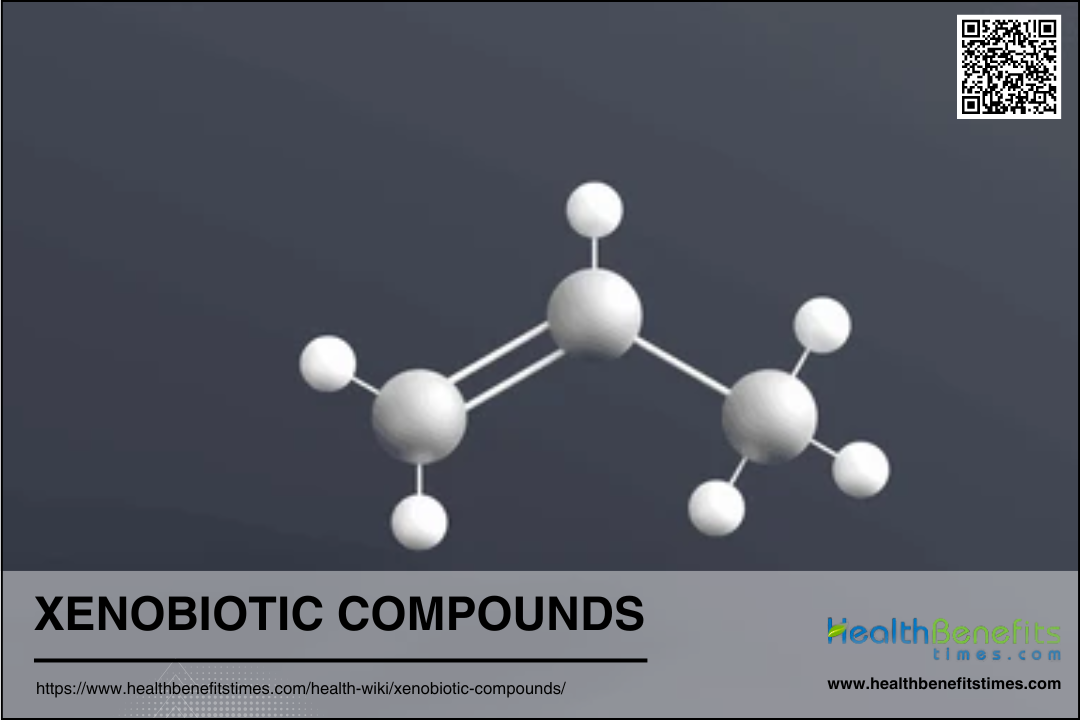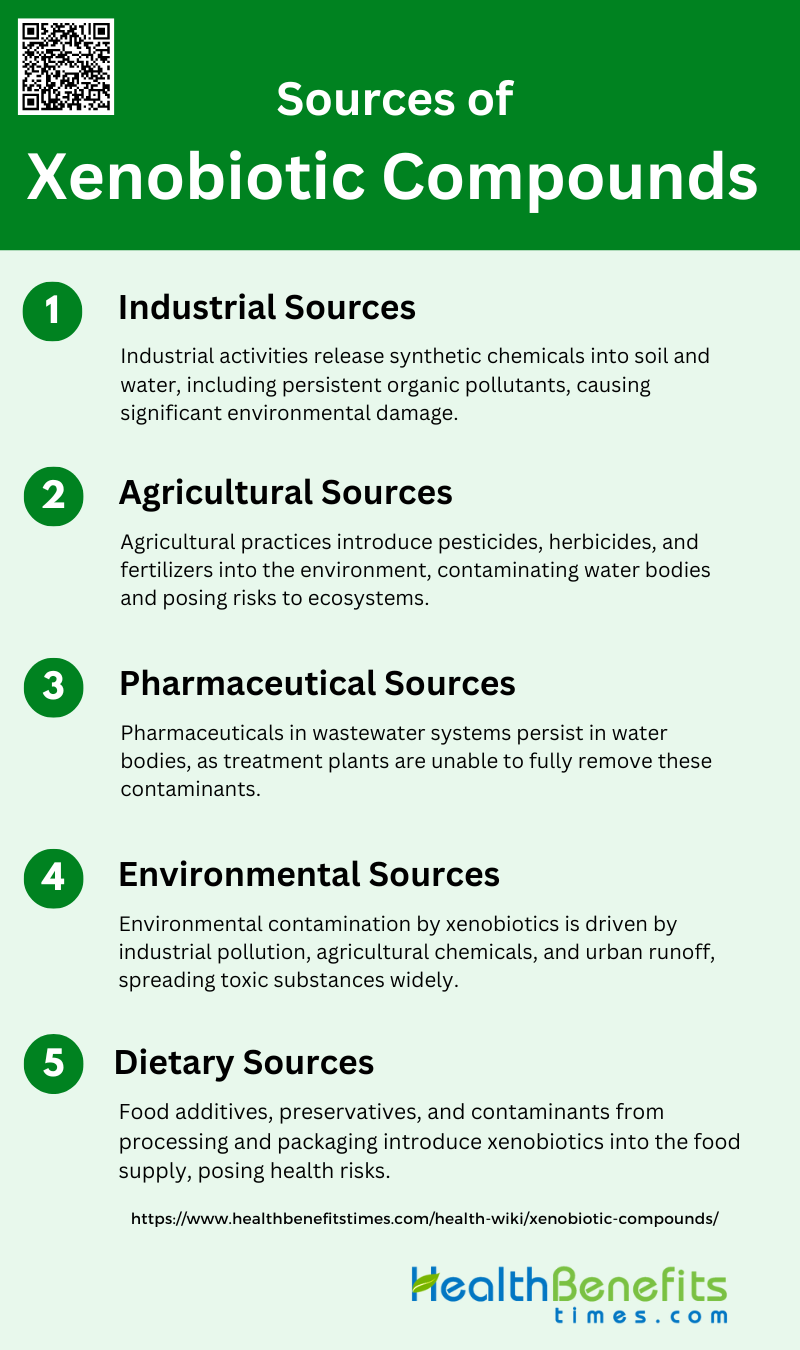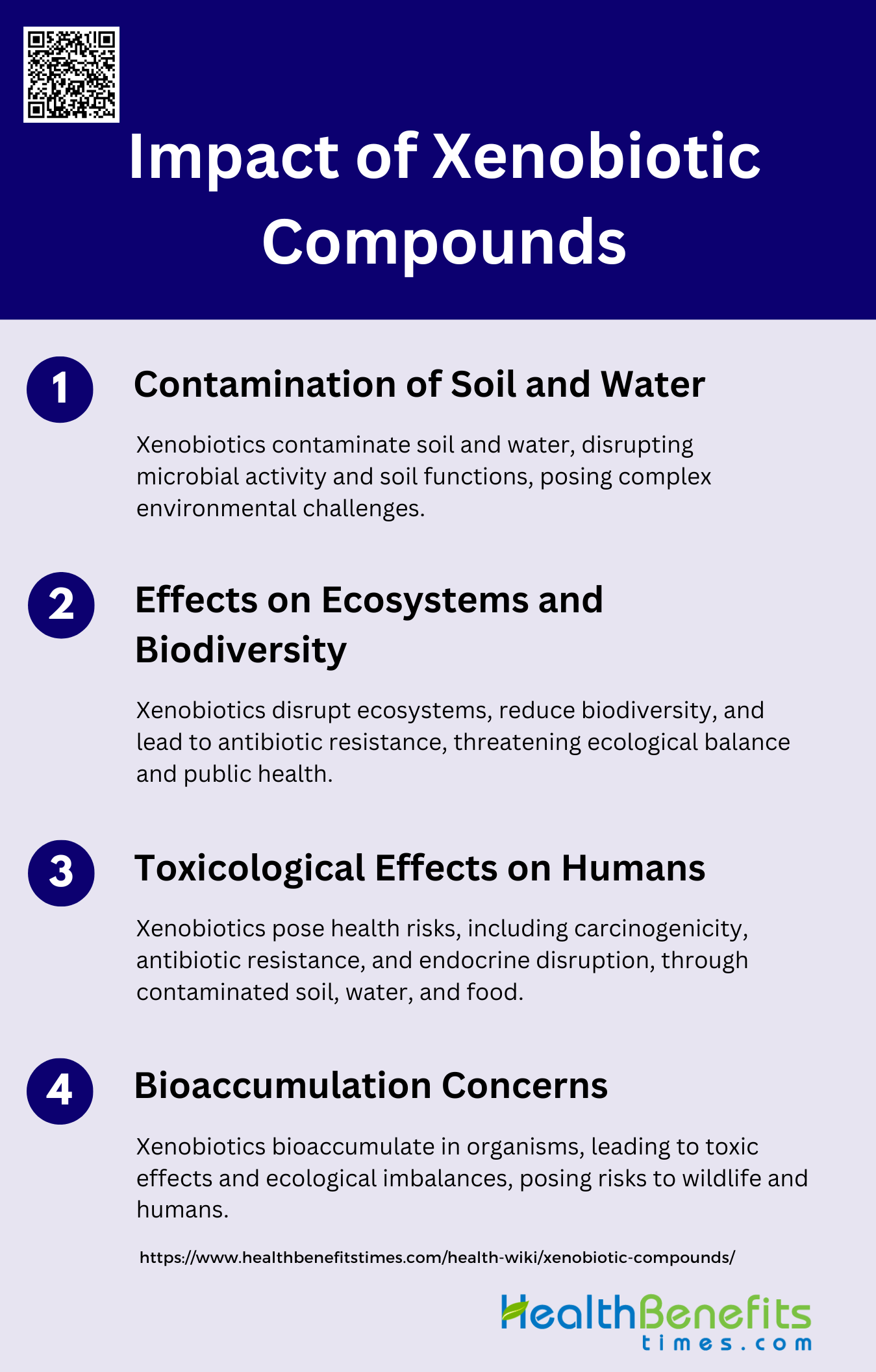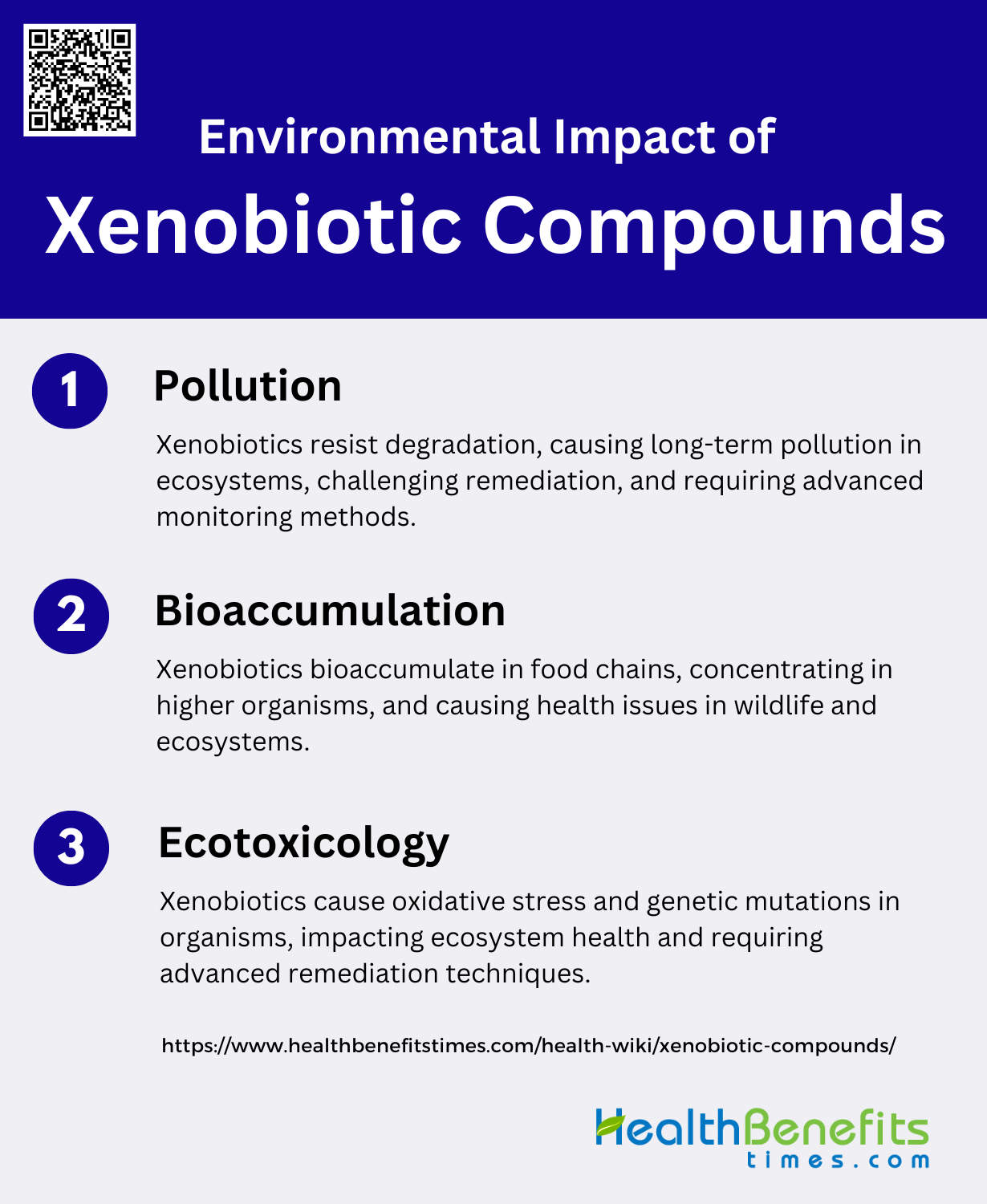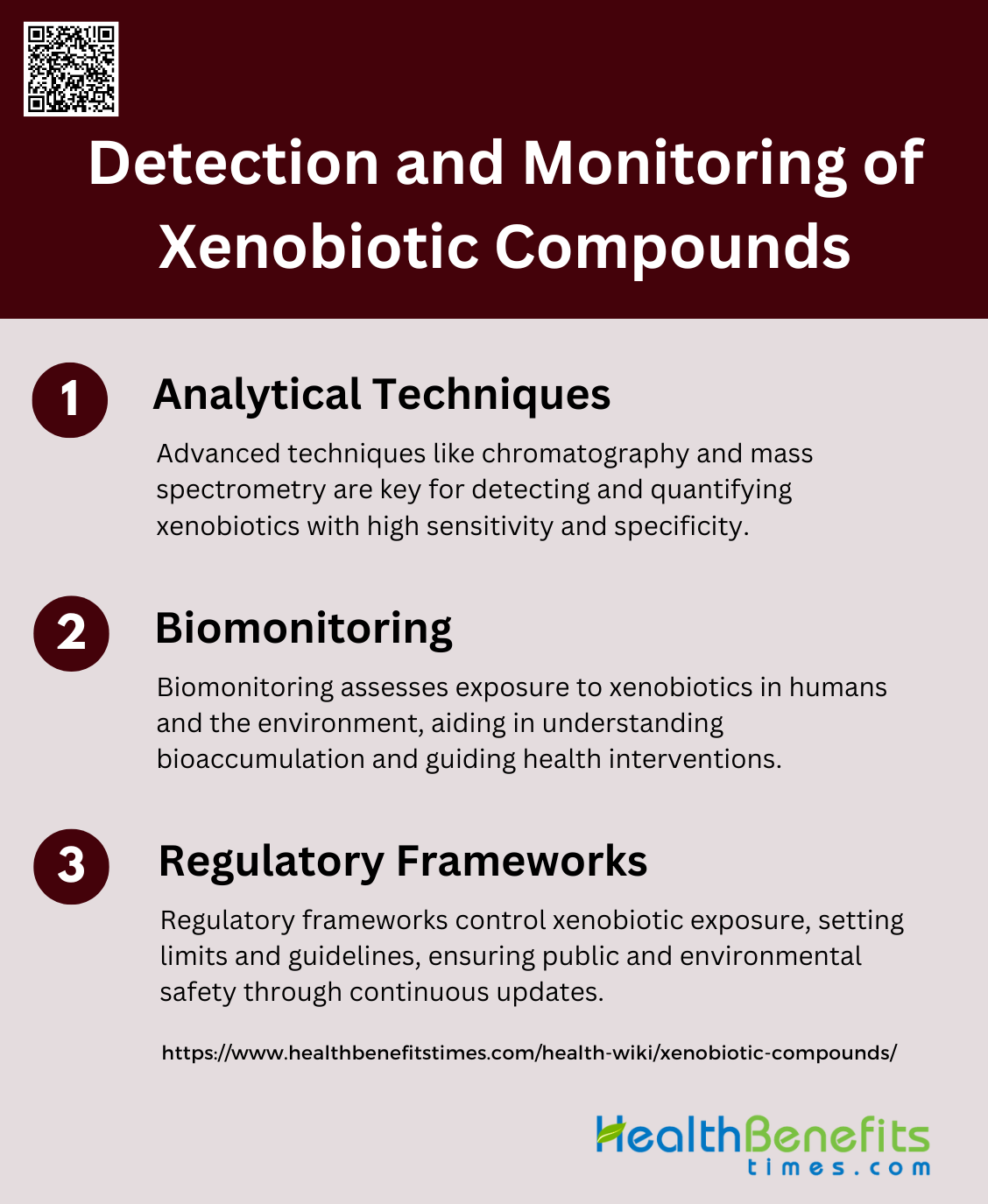Xenobiotic compounds are chemical substances that are foreign to a biological system. These include a wide range of substances such as drugs, environmental pollutants, and synthetic chemicals that are not naturally produced or expected to be present in the body. The human body, as well as other organisms, often metabolizes these compounds through various biochemical pathways to reduce their potential toxicity and facilitate their excretion. Enzymes such as cytochrome P450 play a crucial role in this metabolic process by transforming xenobiotics into more water-soluble forms that can be more easily eliminated from the body. Additionally, the human gut microbiota can significantly alter the chemical structures of xenobiotics, influencing their bioavailability and biological effects, which can have important implications for human health. The biodegradability of these compounds is largely dependent on their chemical structure and the efficiency of the biochemical reactions involved in their breakdown.
Types of Xenobiotic Compounds
Xenobiotic compounds are synthetic chemicals found in the environment that are not naturally occurring. These compounds can have significant impacts on ecosystems and human health. Below are some common types of xenobiotic compounds:
1. Pesticides
Pesticides are a significant category of xenobiotic compounds widely used in agriculture to control pests and increase crop yields. These chemicals include insecticides, herbicides, and fungicides, which are intentionally released into the environment. However, their extensive use has led to contamination of soil and water bodies, posing risks to non-target organisms and disrupting ecosystems. Pesticides such as organophosphorus compounds and various herbicides have been detected in surface waters, indicating their persistence and potential ecological risks. The degradation of these compounds is crucial, and microbial remediation, including the use of Bacillus species, has shown promise in breaking down these toxic substances.
2. Pharmaceuticals and Personal Care Products (PPCPs)
Pharmaceuticals and Personal Care Products (PPCPs) encompass a wide range of substances including antibiotics, hormones, and personal care items like lotions and shampoos. These compounds enter the environment through various pathways, including wastewater discharge and improper disposal. Studies have shown that PPCPs are widely distributed in surface waters, with antibiotics and hormones being particularly prevalent. The presence of these compounds in the environment poses potential risks to aquatic life and human health due to their bioactive nature. Advanced analytical methods, such as SPE-UPLC-MS/MS, have been developed to detect and quantify these contaminants, highlighting the need for effective remediation strategies.
3. Industrial Chemicals
Industrial chemicals are another major group of xenobiotic compounds that include a variety of substances such as solvents, dyes, and explosives. These chemicals are often released into the environment through industrial processes and improper waste disposal, leading to soil and water contamination. The persistence and toxicity of industrial chemicals make them a significant environmental concern. Bacterial remediation, particularly using Bacillus species, has been identified as an effective approach to degrade or transform these toxic substances, thereby mitigating their impact on ecosystems. The use of co-cultures of ligninolytic fungi has also been explored for the bioremediation of recalcitrant industrial chemicals.
4. Plastics and Synthetic Polymers
Plastics and synthetic polymers are ubiquitous in modern society, used in everything from packaging to electronics. However, their durability and resistance to degradation have led to significant environmental pollution. These materials can persist in the environment for long periods, breaking down into microplastics that contaminate soil and water bodies. The environmental impact of plastics and synthetic polymers is profound, affecting wildlife and potentially entering the human food chain. Research into microbial degradation, including the use of white rot fungi, has shown potential in breaking down these persistent pollutants, offering a possible solution to plastic pollution.
5. Heavy Metals
Heavy metals such as lead, mercury, and cadmium are toxic elements that can accumulate in the environment due to industrial activities, mining, and improper waste disposal. These metals pose serious health risks to humans and wildlife, as they can bioaccumulate in organisms and disrupt biological processes. The remediation of heavy metals from contaminated sites is challenging due to their non-degradable nature. However, certain bacterial species, including those from the genus Bacillus, have shown the ability to transform or immobilize heavy metals, reducing their bioavailability and toxicity. The use of microbial co-cultures has also been investigated for the bioremediation of heavy metal-contaminated environments.
Sources of Xenobiotic Compounds
Xenobiotic compounds originate from various human activities and industrial processes. These sources contribute to environmental contamination and pose risks to both ecosystems and human health. Below are some primary sources of xenobiotic compounds:
1. Industrial Sources
Industrial activities are significant contributors to xenobiotic compounds in the environment. Manufacturing processes often release various synthetic chemicals, including dyes, explosives, and other industrial chemicals, into soil and water due to improper waste disposal practices. Chemical waste and emissions from these processes introduce persistent organic pollutants (POPs) and other toxic substances into ecosystems, causing serious damage to both aquatic and terrestrial environments. The United States Environmental Protection Agency (USEPA) has listed several of these substances as priority pollutants due to their high toxicity and persistence.
2. Agricultural Sources
Agricultural practices are another major source of xenobiotic compounds. The use of pesticides, herbicides, and fertilizers introduces numerous toxic chemicals into the environment, which can be transported into surface waters via runoff. These compounds, including pesticide transformation products and adjuvant chemicals, are often found in high concentrations in agricultural runoff, posing significant risks to ecosystems. Additionally, animal feed additives contribute to the contamination of soil and water, further exacerbating the issue.
3. Pharmaceutical Sources
Pharmaceuticals and medical products are increasingly found as contaminants in the environment. Wastewater treatment plants (WWTPs) are not fully equipped to remove pharmaceutical residues, leading to their presence in both wastewater and freshwater systems. Common pharmaceutical contaminants include antibiotics and anti-inflammatory drugs, which are detected at significant levels in various water bodies. The improper disposal and high production rates of these compounds contribute to their persistence and potential risks to human and environmental health.
4. Environmental Sources
Environmental contamination by xenobiotics is a global issue driven by industrial pollution, agricultural chemicals, and urban runoff. Industrial activities release a wide range of toxic substances, including heavy metals and persistent organic pollutants, into the environment. Agricultural chemicals, such as pesticides and fertilizers, further contribute to this contamination through runoff and leaching into water bodies. Urban runoff, containing various pollutants from residential and commercial areas, also plays a significant role in the dissemination of xenobiotics.
5. Dietary Sources
Dietary sources of xenobiotics include food additives, preservatives, and contaminants in food products. These compounds are introduced during food processing and packaging, leading to their presence in the food supply. Contaminants such as pesticide residues and plasticizers can also be found in food products, posing potential health risks to consumers. The persistence and bioaccumulation of these substances in the food chain highlight the need for stringent regulations and monitoring to ensure food safety.
Impact of Xenobiotic Compounds
Xenobiotic compounds can have profound effects on the environment and human health. These synthetic chemicals can disrupt ecosystems, contaminate natural resources, and pose serious health risks. Below are some key impacts of xenobiotic compounds:
1. Contamination of Soil and Water
Xenobiotic compounds, including pesticides, herbicides, and industrial chemicals, have significantly contaminated soil and water environments due to anthropogenic activities and improper waste disposal practices. These compounds are often highly toxic, persistent, and resistant to biodegradation, leading to severe environmental pollution. The contamination of soil and water by xenobiotics disrupts natural microbial and enzymatic activities, resulting in the loss of soil functions essential for sustaining living organisms. Additionally, the co-occurrence of toxic metals and organic xenobiotics in contaminated sites poses complex challenges due to their synergistic toxic effects on ecosystems. Advanced bioremediation techniques, such as microbial degradation, are being explored to mitigate these impacts.
2. Effects on Ecosystems and Biodiversity
The presence of xenobiotic compounds in the environment has detrimental effects on ecosystems and biodiversity. These compounds can disrupt the natural balance of ecosystems by altering microbial community structures and functions, leading to a decline in soil health and fertility. The toxic nature of xenobiotics affects various organisms, from microorganisms to higher trophic levels, causing a reduction in biodiversity and ecosystem services. For instance, antibiotics in soil and water can lead to the development of antibiotic-resistant genes in microbial communities, further complicating ecological interactions and posing a threat to public health. The persistence and bioaccumulation of these compounds in the environment exacerbate their negative impacts on biodiversity.
3. Toxicological Effects on Humans
Xenobiotic compounds pose significant toxicological risks to human health. Exposure to these compounds can occur through contaminated soil, water, and food sources, leading to various health issues. For example, pesticides and polycyclic aromatic hydrocarbons (PAHs) are known to have carcinogenic and mutagenic properties, posing long-term health risks. The presence of antibiotics in the environment contributes to the development of antibiotic-resistant bacteria, which is a major public health concern. Additionally, the bioaccumulation of xenobiotics in the food chain can lead to chronic exposure and adverse health effects, including endocrine disruption, reproductive toxicity, and neurotoxicity.
4. Bioaccumulation Concerns
Bioaccumulation of xenobiotic compounds in the environment is a significant concern due to their persistence and potential to concentrate in living organisms. These compounds can accumulate in the tissues of organisms, leading to higher concentrations at higher trophic levels through the process of biomagnification. This accumulation poses risks to both wildlife and humans, as it can lead to toxic effects even at low environmental concentrations. For instance, the bioaccumulation of antibiotics and other pharmaceutically active compounds in aquatic organisms can disrupt their physiological functions and lead to ecological imbalances. Effective bioremediation strategies, such as the use of biochar and microbial degradation, are being explored to reduce the mobility and bioavailability of xenobiotics in the environment.
Environmental Impact of Xenobiotic Compounds
Xenobiotic compounds can significantly disrupt natural ecosystems. These synthetic chemicals often persist in the environment, leading to contamination of soil, water, and air. Below are some key environmental impacts of xenobiotic compounds:
1. Pollution
Xenobiotics contribute significantly to environmental pollution due to their chemical persistence, toxicity, and widespread use in agriculture and industry. These compounds are often resistant to natural degradation processes, leading to prolonged environmental contamination. The persistence of xenobiotics in ecosystems poses a challenge for remediation efforts and necessitates advanced analytical methods to monitor and manage their presence.
2. Bioaccumulation
Xenobiotics can bioaccumulate in food chains, leading to higher concentrations in organisms at higher trophic levels. This process is complex and influenced by factors such as toxicokinetics, metabolism, and environmental conditions. Persistent organic pollutants (POPs) like PCBs and DDTs are particularly prone to bioaccumulation, posing significant risks to wildlife and ecosystems. The bioaccumulation of xenobiotics can result in adverse health effects for wildlife, including reproductive and developmental issues.
3. Ecotoxicology
The ecotoxicological effects of xenobiotics on non-human organisms and ecosystems are profound. Xenobiotics can induce oxidative stress in aquatic organisms, such as fish, leading to cellular damage and genetic mutations. The biotransformation of xenobiotics in fish and other organisms can alter their toxicity and persistence, impacting overall ecosystem health. Microbial degradation of xenobiotics, although effective, is often slow and requires advanced molecular techniques to enhance the process and mitigate environmental impacts.
Detection and Monitoring of Xenobiotic Compounds
The detection and monitoring of xenobiotic compounds are critical for understanding their impact on human health and the environment. These compounds, often originating from industrial activities, pharmaceuticals, and agricultural practices, require precise and reliable methods for their identification and quantification. Below are key aspects of this process:
1. Analytical Techniques
The detection of xenobiotic compounds in biological and environmental samples relies heavily on advanced analytical techniques. Chromatography, including gas chromatography (GC) and liquid chromatography (LC), is widely used to separate complex mixtures into individual components. Mass spectrometry (MS) is often coupled with chromatography to provide precise identification and quantification of xenobiotics based on their mass-to-charge ratio. These techniques offer high sensitivity and specificity, crucial for detecting trace levels of xenobiotics. Other methods such as nuclear magnetic resonance (NMR) and infrared spectroscopy (IR) are also employed, depending on the nature of the compound and the required analytical precision.
2. Biomonitoring
Biomonitoring is essential for assessing human and environmental exposure to xenobiotic compounds. By measuring these substances in biological matrices like blood, urine, or tissue, researchers can evaluate the extent of exposure and potential health risks. This monitoring helps in understanding the bioaccumulation and persistence of xenobiotics in organisms and ecosystems. It also plays a crucial role in epidemiological studies, linking exposure levels to health outcomes. In the environment, biomonitoring can track the spread and impact of pollutants, guiding remediation efforts and informing public health interventions to reduce exposure and mitigate risks.
3. Regulatory Frameworks
Regulatory frameworks are vital for controlling exposure to xenobiotic compounds, ensuring public and environmental health. Various agencies, such as the Environmental Protection Agency (EPA) in the United States, establish guidelines and permissible exposure limits for these substances. Regulations often require industries to monitor and report the release of xenobiotics, implement safety measures, and reduce emissions. International agreements, like the Stockholm Convention, aim to eliminate or restrict the use of persistent organic pollutants (POPs). These frameworks are continuously updated based on scientific research, ensuring they address emerging threats and incorporate new analytical and biomonitoring data.
Management and Regulation of Xenobiotic Compounds
The management and regulation of xenobiotic compounds are essential to mitigate their adverse effects on human health and the environment. This involves a comprehensive approach encompassing regulatory frameworks and effective management strategies. Below are key aspects of this process:
1. Regulatory Frameworks
International regulations and guidelines play a crucial role in managing xenobiotic compounds. Various laws and regulations have been adopted globally, particularly in the EU, to minimize the negative impacts of xenobiotics on the environment and human health. These regulations emphasize the removal of xenobiotic compounds from the environment in an economically, environmentally, and socially acceptable manner. Governmental agencies, such as the United States Environmental Protection Agency (USEPA), have listed several toxic substances as priority pollutants, underscoring the importance of regulatory oversight in mitigating the risks associated with xenobiotic compounds.
2. Strategies for Management
Pollution prevention and waste management solutions are essential strategies for managing xenobiotic compounds. Bioremediation, which involves using microorganisms to degrade and detoxify pollutants, is gaining popularity as an effective method for removing toxic waste from polluted environments. Additionally, advanced technologies such as nanotechnology offer promising methods for the treatment of xenobiotic compounds, providing better treatment outcomes compared to traditional chemical treatments. Constructed wetlands have also been identified as a low-cost and effective technology for treating various types of sewage, including domestic and industrial wastewater, thereby preventing the deposition of xenobiotic compounds into the environment.
FAQs
1. What are the most common ways xenobiotic compounds enter the human body?
Xenobiotic compounds can enter the human body through ingestion (e.g., contaminated food or water), inhalation (e.g., air pollutants), dermal exposure (e.g., through the skin via contact with contaminated soil or chemicals), or injection (e.g., through medical procedures).
2. How do xenobiotic compounds affect human health in the long term?
Long-term exposure to xenobiotic compounds can lead to chronic health issues such as cancer, endocrine disruption, reproductive toxicity, neurotoxicity, and the development of antibiotic-resistant bacteria. The specific health impact depends on the type of compound, level of exposure, and individual susceptibility.
3. Are there natural xenobiotic compounds, or are they all synthetic?
While most xenobiotic compounds are synthetic, some naturally occurring substances can also be considered xenobiotics if they are foreign to a particular biological system. Examples include certain plant alkaloids or compounds produced by microorganisms that are not usually found in the human body.
4. How do regulatory agencies determine safe levels of exposure to xenobiotic compounds?
Regulatory agencies, such as the Environmental Protection Agency (EPA), conduct risk assessments based on scientific studies that evaluate the toxicity, exposure levels, and potential health effects of xenobiotic compounds. These agencies establish guidelines and permissible exposure limits to minimize health risks.
5. What role do xenobiotics play in the development of drug resistance?
Xenobiotics, particularly antibiotics, can contribute to the development of drug-resistant bacteria when they are present in the environment at sub-lethal concentrations. These conditions promote the survival and proliferation of resistant strains, which can be transferred to humans and animals.
6. How do xenobiotics affect non-target organisms in ecosystems?
Non-target organisms, such as beneficial insects, birds, and aquatic life, can be harmed by xenobiotic compounds. These substances can disrupt reproductive systems, cause genetic mutations, and lead to population declines, ultimately affecting biodiversity and ecosystem stability.
7. What are the challenges in biodegrading xenobiotic compounds?
The biodegradation of xenobiotic compounds can be challenging due to their chemical complexity, resistance to breakdown, and potential to form toxic by-products during degradation. Some compounds require specific microbial strains or environmental conditions for effective bioremediation.
8. Can xenobiotics in the environment be completely eliminated, or are they always present at some level?
While complete elimination of xenobiotics from the environment is challenging, especially for persistent organic pollutants (POPs), advanced bioremediation techniques and regulatory measures can significantly reduce their levels. However, trace amounts may still persist due to their widespread use and long-term environmental stability.
9. What is the difference between bioaccumulation and biomagnification of xenobiotic compounds?
Bioaccumulation refers to the build-up of xenobiotic compounds in the tissues of an individual organism over time. Biomagnification, on the other hand, occurs when the concentration of these compounds increases as they move up the food chain, resulting in higher levels in top predators.
10. How do xenobiotic compounds interact with other environmental pollutants?
Xenobiotic compounds can interact with other environmental pollutants, sometimes creating synergistic effects that amplify their toxicity. These interactions can complicate remediation efforts and pose greater risks to ecosystems and human health.


